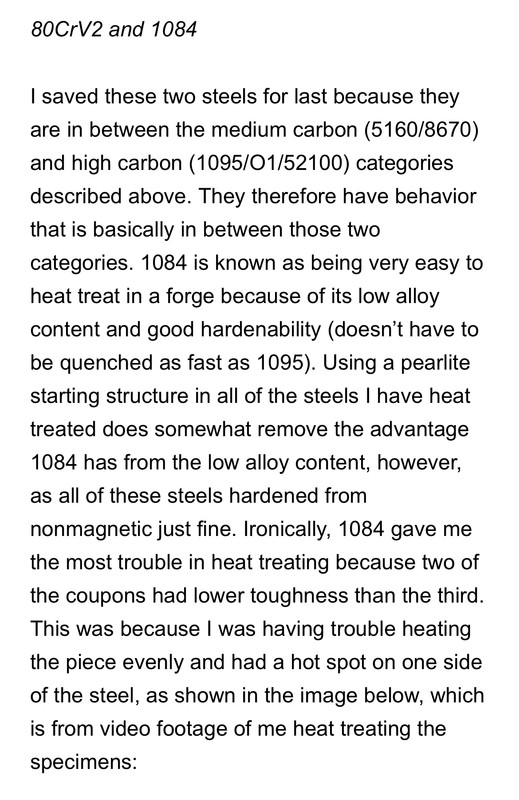I think I may have just solved a problem that I have, but I didn't know that I had it until heat treating samples.
The dilemma - my samples of O1 and 26c3 matched toughness and hardness curves that larrin published. I've done hundreds of both of these before sending samples (counting old files with 26c3, they are *very* similar both in snapped samples and resultant hardness and feel on he stones.
I think what I just found is that the color of 1084 (thus the temperature) when transitioning to nonmagnetic is lower than O1 and 26c3.
can anyone confirm that? I think when I assume I"m doing subcritical cycles with 1084, which it probably doesn't gain much from, I'm actually quenching new grains in over and over. I tried that by heating 26c3 and files past critical and quenching each time in a cycle of three - the grain coarsens.
The tail end of what I do with 26c3 is heat it past the recommended furnace temp, but quickly and then quench. this might take 10 or 15 seconds, and I can't see observable grain growth.
With 1084, 10 second more of heating under my small scope even with no thermal cycles doubles the grain size.
I never considered that the color temperature of steel would be that much different when they're all pretty much plain - that is, what they look like when they change to nonmagnetic.
This may also help to solve the problem I mentioned below -wanting something that's in its tempering sweet spot for chisels (harder than knives - people don't complain about chisels that won't bend back and forth, they complain when the edges roll or chip, so the bias is to chase a little more strength than toughness).
I realize this isn't a popular thing - heat treat in forge with no attempt at any duration of temperature soaking, but would guess that there is some historical use of it (not recently) before thermocouples were available. And I've had a lot of 200 year old tools with good toughness and strength balance (think thin somewhat harder slicing knife - something that doesn't hold its burr much when sharpening).
The dilemma - my samples of O1 and 26c3 matched toughness and hardness curves that larrin published. I've done hundreds of both of these before sending samples (counting old files with 26c3, they are *very* similar both in snapped samples and resultant hardness and feel on he stones.
I think what I just found is that the color of 1084 (thus the temperature) when transitioning to nonmagnetic is lower than O1 and 26c3.
can anyone confirm that? I think when I assume I"m doing subcritical cycles with 1084, which it probably doesn't gain much from, I'm actually quenching new grains in over and over. I tried that by heating 26c3 and files past critical and quenching each time in a cycle of three - the grain coarsens.
The tail end of what I do with 26c3 is heat it past the recommended furnace temp, but quickly and then quench. this might take 10 or 15 seconds, and I can't see observable grain growth.
With 1084, 10 second more of heating under my small scope even with no thermal cycles doubles the grain size.
I never considered that the color temperature of steel would be that much different when they're all pretty much plain - that is, what they look like when they change to nonmagnetic.
This may also help to solve the problem I mentioned below -wanting something that's in its tempering sweet spot for chisels (harder than knives - people don't complain about chisels that won't bend back and forth, they complain when the edges roll or chip, so the bias is to chase a little more strength than toughness).
I realize this isn't a popular thing - heat treat in forge with no attempt at any duration of temperature soaking, but would guess that there is some historical use of it (not recently) before thermocouples were available. And I've had a lot of 200 year old tools with good toughness and strength balance (think thin somewhat harder slicing knife - something that doesn't hold its burr much when sharpening).

